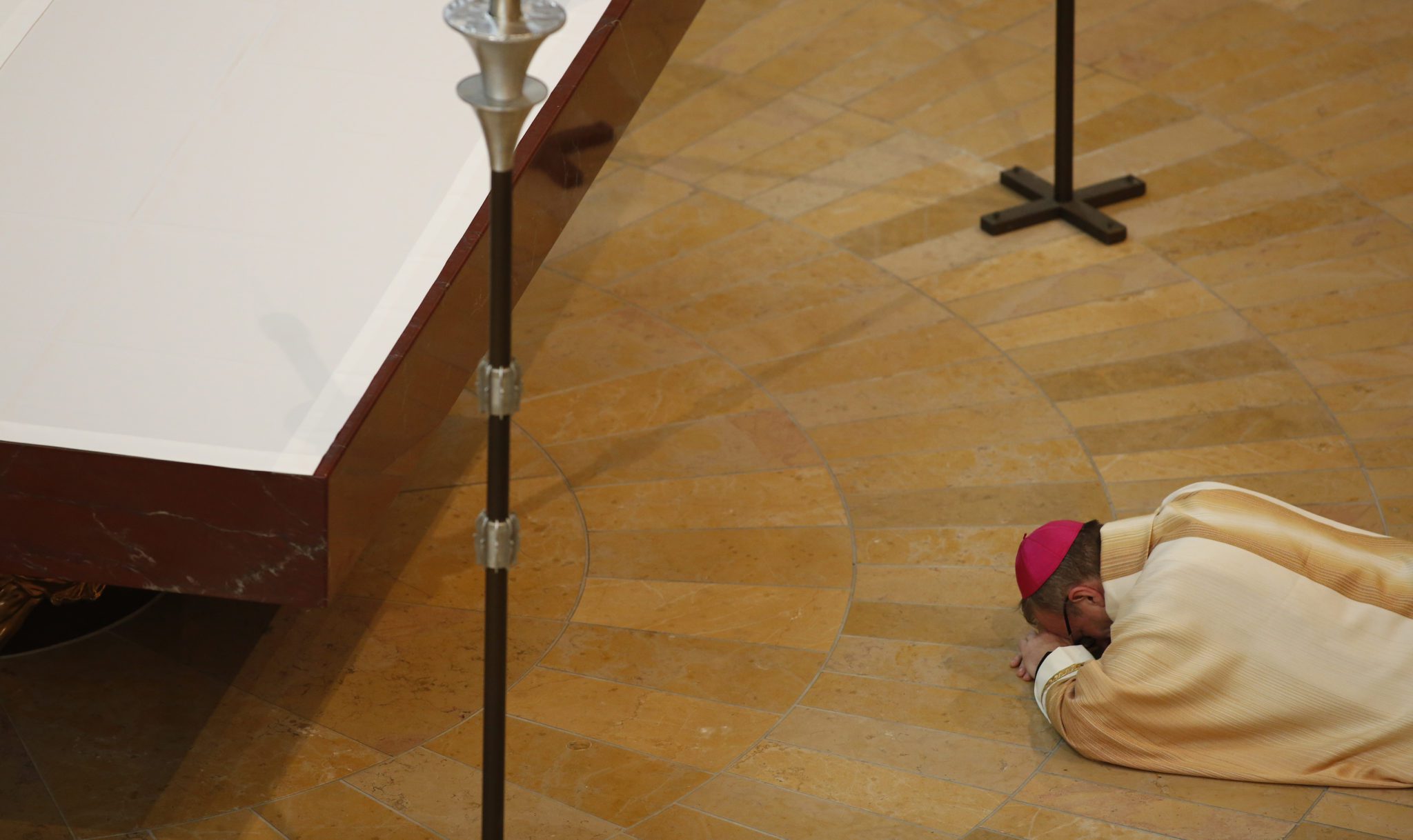Bishop Barron and His Bible

Every Advent, columnists and periodicals offer their picks for book of the year. My selection this year will be an unusual one: a book that was composed nearly two millennia ago, in an edition that hasn’t been fully published. I’m speaking of the Word on Fire Bible, the ongoing project by Bishop Robert Barron and his Word on Fire ministry to re-present the Good Book to a nation starved for moral and spiritual truth—and for beauty.
Barron, the 62-year-old auxiliary bishop of Los Angeles, is the greatest living heir to Fulton Sheen, the pioneering televangelist who beamed the Christian idea into millions of American living rooms in the last century. Like Sheen, who dominated the chief media forms of his time (radio and television), Barron is a master of today’s social platforms. Sheen aimed for maximal lucidity without compromising on intelligence or orthodoxy, and the same is true of Barron.
Like Sheen, Barron is possessed of a seemingly boundless energy. A bishop, even one encouraged by his superiors to carry out a media ministry, has many duties: duties of pastoral care, of administration, and of prayer. I happen to know that Bishop Barron spends a lot of time kneeling on his prie dieu. In between, he somehow finds time to produce an unimaginable volume of books, essays, columns, documentaries, YouTube videos, interviews and so on.
There is one difference. Sheen was eminently a figure of the postwar Protestant-Catholic-Jewish consensus; indeed, he helped build it. Barron, by contrast, finds himself preaching to a sharply polarized age. Some liberal Catholics see their role chiefly as carrying on liberalism’s censuring mechanisms within the life of the Church, and they often reproach the bishop for engaging New York Times-certified Bad People like, well, yours truly.
He also gets heat from the other end of the ecclesial spectrum, from crankier traditionalists whose measure of faith is vituperation against the hierarchy and Pope Francis especially. The bishop might be leading many souls to the Church, and speaking especially to the atomized young men and women whose spirits are first kindled by the likes of Jordan Peterson. But because Barron doesn’t state everything exactly as the trads would prefer, they dismiss him.
This dual opposition doesn’t make Barron a “centrist” (whatever that means in a Catholic context). It just means he is prepared to look beyond the cramped horizon of our partisan oppositions to propose a smart, robust, inviting Catholicism. Would that men like Barron benefited from material conditions that made evangelization easier—“structures of assent,” as my friend the theologian Chad Pecknold calls them.
Creating and maintaining such structures is the task of the Catholic laity, as the Vatican II decree Apostolicam Actuositatem makes clear. But in the meanwhile, someone has to evangelize a generation immiserated by neoliberalism, distracted by screens, addicted to porn and painkillers, alienated by divorce and de-natured by gender ideology. Earlier missionaries could take for granted that un-evangelized peoples knew the difference between men and women — how much harder and more rewarding the work of a Barron, who must start by teaching American YouTubers about nature as a legible whole (let alone the supernatural).
And yet, Barron does this work, generally with an unflappable smile. A pair of messages unites his massive output. First, he teaches the contemporary gentiles that the legibility of nature points to a divine author. That much, of course, the adherents of various monotheistic faiths can agree on, and Barron the trained Thomist (gently) makes mincemeat of the new atheism.
Second, Barron insists that this author of creation took on human nature so as to elevate the human to the level of the divine. Again and again, Barron rails against attempts to “domesticate” the God-Man, to reduce him to a mere ethicist or spiritual guru. No, Jesus is too “disconcerting” for that, as Barron puts it in his acclaimed Catholicism series: Either Christ really is God made flesh, or he is a mad or evil man, whom we would be right to reject.
But how can an age like ours get to know this Jesus, to test his claims that he is the Son of God?
One way Barron answers this yearning is through the Word on Fire Bible. It’s a physically and visually delightful book, packed with commentary from the Church Fathers and more recent sages like Aquinas, Chesterton, Flannery O’Connor, and Barron himself. Barron’s own commentary on the calling of Saint Matthew reduced me to tears:
Notice how magnetic the converted Matthew has become. To the party flock all of his fellow tax collectors and other sinners. The call of Jesus has summoned Matthew and through him a whole host of others similarly excluded, by their own self-absorption, from the thrill of the divine life. We can only imagine how rowdy, impolite and socially questionable this gang of lowlifes is. But there they are, because of Matthew, around the shepherd of Israel.
Every few pages, readers are treated to a painting from the Church’s great repository of sacred art, so that the likes of Fra Angelico and Caravaggio may do their work of evangelization, too. So far, the four Gospels have been published (in one volume). At the risk of sounding like a door-to-door Bible salesman, I must say: It makes for a perfect Christmas gift. A second, equally glorious volume, which I’ve had a chance to preview, includes Acts and the epistles. That’s forthcoming in early 2022.
Meanwhile, take a bow, Your Excellency.